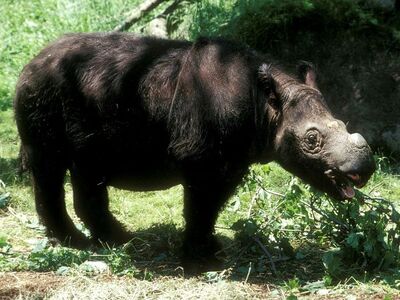
The sumatran rhino is the closest living relative of the woolly rhino
Fast Facts[]
- Type
- Mammal
- Diet
- Herbivore
- Average life span in captivity
- 35 to 40 years
- Size
- Height, 48 to 58 in (1.2 to 1.5 m), Length, 8 to 10 ft (2.5 to 3.2 m)
- Weight
- About 1,760 lbs (800 kg)
- Group name
- Solitary
- Protection status
- Endangered
- Did you know?
- Fewer than 400 Sumatran rhinos are thought to exist, making it one of the rarest large mammals in the world.
- The two-horned Sumatran rhinoceros shares the bleak distinction of world’s most endangered rhino with its regional cousin, the Javan rhino. The smallest of the rhino family, the Sumatran rhinoceros lives in isolated pockets in the dense mountain forests of Malaysia, Indonesia, and possibly Myanmar (Burma).
Sumatran rhinos are generally solitary creatures that feed on fruit, twigs, leaves, and shrubs. Like other rhinos they have a keen sense of smell and sharp hearing, and they leave a network of scented trails throughout the forest in order to find one another.
As the smallest rhino, they weigh about 1,760 pounds (800 kilograms), and grow to a height near 5 feet (1.5 meters) at the shoulders and 8 to 10 feet (2.5 to 3.2 meters) in length. Unlike most other rhinos, their hide, dark red-brown in color, is covered with patches of short, dark, stiff hair. The hair helps keep mud caked to the body, which cools the hide and protects it from insects.
The Sumatran rhino’s two horns are considerably smaller than those of their African relatives, the black and white rhinos. The anterior horn may grow up to 31 inches (79 centimeters), but is normally much smaller, while the posterior horn may grow up to 3 inches (10 centimeters), but is generally no more than a hump.
The horns for which rhinos are so well known have been their downfall. Many animals have been killed for this hard growth, which is made of a hair-like substance and is revered for medicinal use in China, Taiwan, Hong Kong, and Singapore. The horn is also valued in the Middle East, Yemen especially, and North Africa as an ornamental dagger handle.
Listed as critically endangered, there are thought to be fewer than 400 Sumatran rhinos in existence today. While a number of these animals are kept in zoos, they rarely breed in captivity. In 2001 a calf born in the Cincinnati Zoo in Ohio was the first Sumatran rhino born in the United States, and the first successful captive delivery in over 100 years. The main threats to their survival in the wild include poaching and habitat encroachment by humans. Unlike its Indian and African cousins, the critically endangered Sumatran rhinoceros is covered with patches of stiff hair, most prominent on its ears.'''''